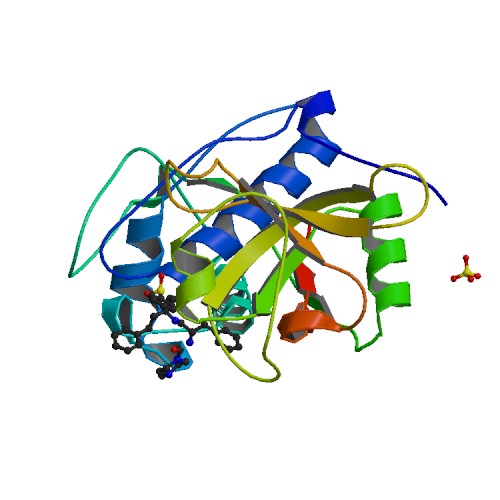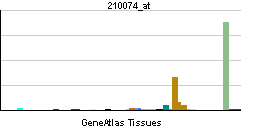CTSL2
Jump to navigation
Jump to search
| Cathepsin L2 | |||||||||||||
|---|---|---|---|---|---|---|---|---|---|---|---|---|---|
 PDB rendering based on 1fh0. | |||||||||||||
| |||||||||||||
| Identifiers | |||||||||||||
| Symbols | CTSL2 ; CATL2; CTSU; CTSV; MGC125957 | ||||||||||||
| External IDs | Template:OMIM5 Template:MGI HomoloGene: 74298 | ||||||||||||
| |||||||||||||
| RNA expression pattern | |||||||||||||
 | |||||||||||||
| More reference expression data | |||||||||||||
| Orthologs | |||||||||||||
| Template:GNF Ortholog box | |||||||||||||
| Species | Human | Mouse | |||||||||||
| Entrez | n/a | n/a | |||||||||||
| Ensembl | n/a | n/a | |||||||||||
| UniProt | n/a | n/a | |||||||||||
| RefSeq (mRNA) | n/a | n/a | |||||||||||
| RefSeq (protein) | n/a | n/a | |||||||||||
| Location (UCSC) | n/a | n/a | |||||||||||
| PubMed search | n/a | n/a | |||||||||||
Cathepsin L2, also known as CTSL2, is a human gene.[1]
The protein encoded by this gene, a member of the peptidase C1 family, is a lysosomal cysteine proteinase that may play an important role in corneal physiology. This gene is expressed in colorectal and breast carcinomas but not in normal colon, mammary gland, or peritumoral tissues, suggesting a possible role for this gene in tumor processes.[1]
References
Further reading
- Santamaría I, Velasco G, Cazorla M; et al. (1998). "Cathepsin L2, a novel human cysteine proteinase produced by breast and colorectal carcinomas". Cancer Res. 58 (8): 1624–30. PMID 9563472.
- Adachi W, Kawamoto S, Ohno I; et al. (1998). "Isolation and characterization of human cathepsin V: a major proteinase in corneal epithelium". Invest. Ophthalmol. Vis. Sci. 39 (10): 1789–96. PMID 9727401.
- Brömme D, Li Z, Barnes M, Mehler E (1999). "Human cathepsin V functional expression, tissue distribution, electrostatic surface potential, enzymatic characterization, and chromosomal localization". Biochemistry. 38 (8): 2377–85. doi:10.1021/bi982175f. PMID 10029531.
- Itoh R, Kawamoto S, Adachi W; et al. (1999). "Genomic organization and chromosomal localization of the human cathepsin L2 gene". DNA Res. 6 (2): 137–40. PMID 10382972.
- Somoza JR, Zhan H, Bowman KK; et al. (2000). "Crystal structure of human cathepsin V.". Biochemistry. 39 (41): 12543–51. PMID 11027133.
- Strausberg RL, Feingold EA, Grouse LH; et al. (2003). "Generation and initial analysis of more than 15,000 full-length human and mouse cDNA sequences". Proc. Natl. Acad. Sci. U.S.A. 99 (26): 16899–903. doi:10.1073/pnas.242603899. PMID 12477932.
- Bernard D, Méhul B, Thomas-Collignon A; et al. (2003). "Analysis of proteins with caseinolytic activity in a human stratum corneum extract revealed a yet unidentified cysteine protease and identified the so-called "stratum corneum thiol protease" as cathepsin l2". J. Invest. Dermatol. 120 (4): 592–600. doi:10.1046/j.1523-1747.2003.12086.x. PMID 12648222.
- Tolosa E, Li W, Yasuda Y; et al. (2003). "Cathepsin V is involved in the degradation of invariant chain in human thymus and is overexpressed in myasthenia gravis". J. Clin. Invest. 112 (4): 517–26. doi:10.1172/JCI200318028. PMID 12925692.
- Clark HF, Gurney AL, Abaya E; et al. (2003). "The secreted protein discovery initiative (SPDI), a large-scale effort to identify novel human secreted and transmembrane proteins: a bioinformatics assessment". Genome Res. 13 (10): 2265–70. doi:10.1101/gr.1293003. PMID 12975309.
- Humphray SJ, Oliver K, Hunt AR; et al. (2004). "DNA sequence and analysis of human chromosome 9". Nature. 429 (6990): 369–74. doi:10.1038/nature02465. PMID 15164053.
- Yasuda Y, Li Z, Greenbaum D; et al. (2004). "Cathepsin V, a novel and potent elastolytic activity expressed in activated macrophages". J. Biol. Chem. 279 (35): 36761–70. doi:10.1074/jbc.M403986200. PMID 15192101.
- Gerhard DS, Wagner L, Feingold EA; et al. (2004). "The status, quality, and expansion of the NIH full-length cDNA project: the Mammalian Gene Collection (MGC)". Genome Res. 14 (10B): 2121–7. doi:10.1101/gr.2596504. PMID 15489334.
- Hagemann S, Günther T, Dennemärker J; et al. (2005). "The human cysteine protease cathepsin V can compensate for murine cathepsin L in mouse epidermis and hair follicles". Eur. J. Cell Biol. 83 (11–12): 775–80. PMID 15679121.
- Cheng T, Hitomi K, van Vlijmen-Willems IM; et al. (2006). "Cystatin M/E is a high affinity inhibitor of cathepsin V and cathepsin L by a reactive site that is distinct from the legumain-binding site. A novel clue for the role of cystatin M/E in epidermal cornification". J. Biol. Chem. 281 (23): 15893–9. doi:10.1074/jbc.M600694200. PMID 16565075.
- Burden RE, Snoddy P, Jefferies CA; et al. (2007). "Inhibition of cathepsin L-like proteases by cathepsin V propeptide". Biol. Chem. 388 (5): 541–5. doi:10.1515/BC.2007.053. PMID 17516850.
- Viken MK, Sollid HD, Joner G; et al. (2007). "Polymorphisms in the cathepsin L2 (CTSL2) gene show association with type 1 diabetes and early-onset myasthenia gravis". Hum. Immunol. 68 (9): 748–55. doi:10.1016/j.humimm.2007.05.009. PMID 17869649.
| This protein-related article is a stub. You can help Wikipedia by expanding it. |